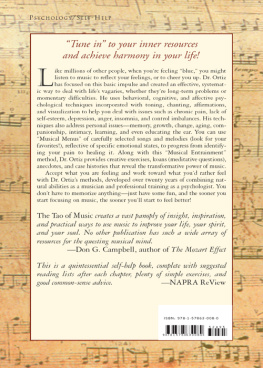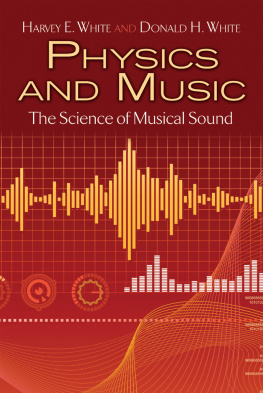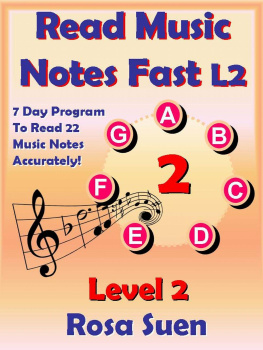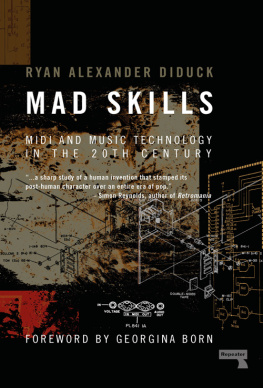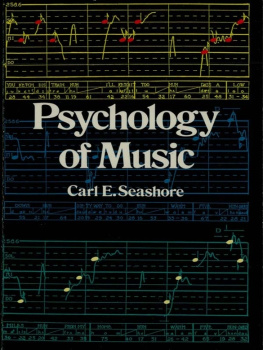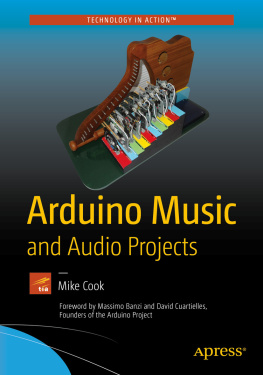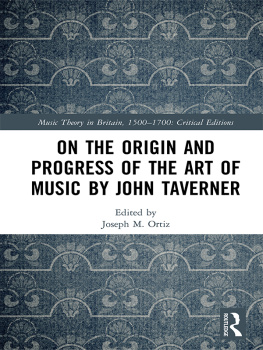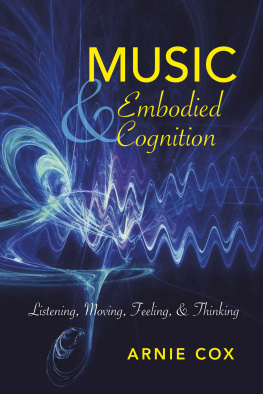
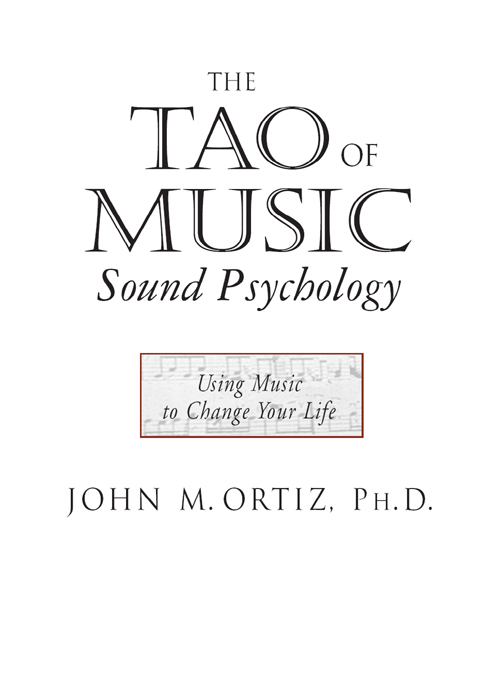
First published in 1997 by
Red Wheel / Weiser, LLC
with offices at
500 Third Street, Suite 230
San Francisco, CA 94107
www.redwheelweiser.com
Copyright 1997 John M. Ortiz
All rights reserved. No part of this publication may be reproduced or transmitted in any form or by any means, electronic or mechanical, including photocopying, recording, or by any information storage and retrieval system, without permission in writing from Samuel Weiser, Inc.
Reviewers may quote brief passages.
ISBN: 978-1-57863-008-0
Library of Congress Cataloging-in-Publication Data
Ortiz, John M.
The Tao of music: sound psychology / John M. Ortiz.
p. cm.
Includes bibliographical references and index.
ISBN 1-57863-008-8 (pbk.: alk. paper)
1. Music therapy. 2. Music--Psychology. 3. Taoism.
I. Title.
ML3920.076 1997
615.85154--dc21
97-9196
CIP
MN
Typeset in 11 point Garamond
Cover and text design by Kathryn Sky-Peck
Printed in the United States of America
10 9 8 7 6
MV
The paper used in this publication meets the minimum requirements of the American National Standard for Permanence of Paper for Printed Library Materials Z39.48-1984.
www.redwheelweiser.com
www.redwheelweiser.com/newsletter
To the men in my life, Manolo and Paco, for their courage, strength, and sense of humor.
To the women in my life, Gladyswho taught me reading, writing, and creativity,and Roz, my life partner, for their support, encouragement, unconditional love, and unwavering belief in me.
Table of Contents
Exercises
Exercise 1. Lifting a Depressed Mood
Exercise 2. Moving Out of the Blues
Exercise 3. Pain Elimination / Reduction
Exercise 4. Self-Enhancing: Changing Noise to Harmony
Exercise 5. Letting Go of Chronic Anger
Exercise 6. Diverting Another Person's Anger
Exercise 7. The Angry Troll: Dispelling Anger through Silent Humor
Exercise 8. Sound Sleeping
Exercise 9. Giving Up Control: Letting Go
Exercise 10. Reducing Stress
Exercise 11. Spiral Sojourn through Musical Memories
Exercise 12. Time Management through Music
Exercise 13. Using Music to Speed Your Pace
Exercise 14. Using Music to Slow Your Pace
Exercise 15. Using Music to Trigger Emotional Responses
Exercise 16. Creating New Memories
Exercise 17. Beating Procrastination
Exercise 18. Rejuvenation through Music
Exercise 19. Training through Entrainment
Exercise 20. Listening and Communication Enhancement
Exercise 21. Enhancing Listening Sensitivity
Exercise 22. The Magic Nightclub
Exercise 23. Using Music to Memorize Word Lists
Exercise 24. Improving Learning Skills
Exercise 25. Listening
Exercise 26. Sound Convergence
Exercise 27. Finding Your Center
Exercise 28. Centering through Music
Exercise 29. Enhancing Creativity
Exercise 30. Letting Go
Exercise 31. Selecting Your Soundtracks
Exercise 32. Clearing the Mind
Exercise 33. Unexpecting
Exercise 34. Discovering Your Magical Breath
Exercise 35. Finding Your Mantric Sound
Exercise 36. Discovering Your Personal Chant
Exercise 37. Toning through Natural Release
Exercise 38. Toning While Making Love
Exercise 39. Toning During a Stroll
Exercise 40. The Spiral Sojourn
Exercise 41. Accessing Your Inner Guide
Musical Menus
Musical Menu 1. Anti-Depressed Mood Entrainment Sequence
Musical Menu 2. Bonding and Moving Away from a Depressed Mood
Musical Menu 3. Stimulating Music
Musical Menu 4. Inspirational Music
Musical Menu 5. Soothing Music (Rhythmic Synchronicity)
Musical Menu 6. Music for Dealing with Anger
Musical Menu 7. Top Songs of the '30s
Musical Menu 8. Top Songs of the '40s
Musical Menu 9. Top Songs of the '50s
Musical Menu 10. Top Songs of the '60s
Musical Menu 11. Top Songs of the '70s
Musical Menu 12. Entrainment Sequence: Big Band
Musical Menu 13. Entrainment Sequence: '60s Pop
Musical Menu 14. Entrainment Sequence for Limited Budgets
Musical Menu 15. Romantic Magic Nightclub
Musical Menu 16. Music Box Tunes
Musical Menu 17. Centering Music
Musical Menu 18. Meditation Music
Musical Menu 19. Music for Altered States
Musical Menu 20. Music for Letting Go
Musical Menu 21. Sixty-five Years of Song-Title Affirmations
Musical Menu 22. Mantric Music
Musical Menu 23. Chanting Music
Acknowledgments
I would like to thank the following people in my life. Nancy for pointing the way and Josefina for the lifelong reminders; Bibi, Carida, and Marieand brother Frankfor forever believing without expectations; Dr. Ed Herr, my mentor, and Betty, for opening the doors and giving me the opportunity to become; and John, Paul, George and Ringo for the soundtrack of my life.
MUSIC IS THE SOUND OF LIFE, CELEBRATING ITSELF.
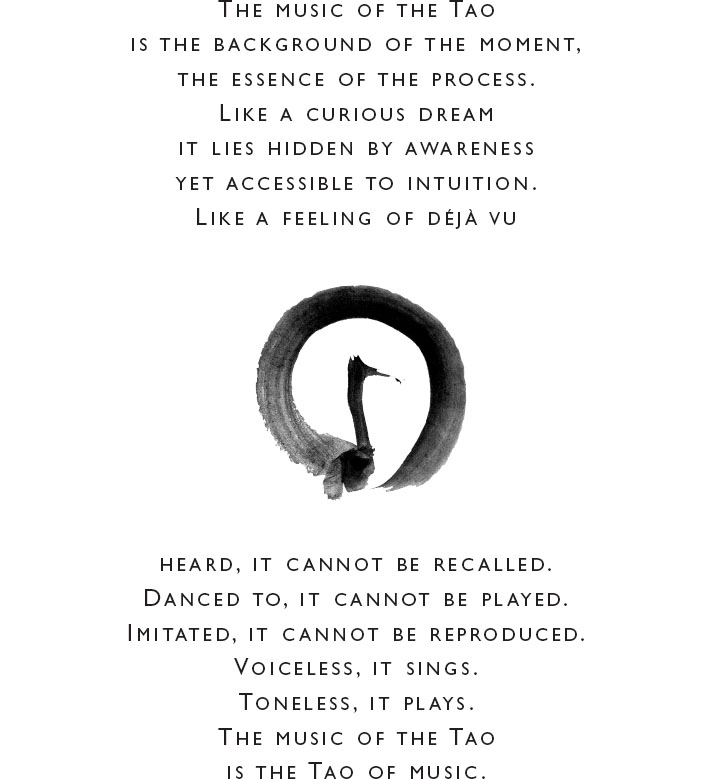
THE MUSIC OF THE TAO IS THE SOUND OF ONE HAND CLAPPING.
Introduction
The dance of life goes on within and around us.
I n 1964, the Beatles invaded my world and, for the first time in my life, I heard my inner music. From that moment on, music always provided a place where I could go. It was a friend to whom I could turn, a magical haven. When I felt sad, I knew what music would make me feel happy. When stressed, I knew which tunes would help me to relax. When feeling inhibited I knew the songs that would help me to let go, that would allow me to be myself. When lonely, I knew I could spin a few records (black vinyl 45s), or plug in my guitar, and soon, my loneliness would disappear. If, for some reason, the loneliness refused to go away, the music somehow made it okay to be alone. Maybe it was a sense that the person who wrote or recorded those tunes had similar feelings or shared similar concerns. That commonality made my concerns a bit more universal and, somehow, less overwhelming. Through their music, those peoplethose famous strangerscommunicated a sense of harmony and purpose that other adults could never quite get across through their lectures, rituals, or seemingly irrelevant traditions. Music, it seemed, had awoken my awareness.
The music seemed never to push from behind, but rather to pull forward. It challenged without threatening. Melodies seemed to add color to my world, while beats and rhythms provided movement. Rather than This is the way it is, the music seemed to say, This is one of the ways it can be. The music never told us what we should do, or why we should do it. It was never about shoulds, or whys. It was about change, energy, and vibrations.
{M}usic represents a sort of rhythmic consensus, a consensus of the core culture.
Well-meaning parents may tell us to think for ourselves, but often have little or no idea how to help our minds from recycling constant concerns, unnecessary worries, destructive ideas, and negative images. Teachers may be excellent at teaching us how to solve algebra problems and conjugate Latin verbs, but there doesn't seem to be any room in the curriculum to teach us how to handle depression, let go of anger, or simply communicate with others effectively. Some role models are quick at telling us how we should behave, what we ought to think, and which attitudes we must have, as if there were no choices. Emphasis is typically on reliving or avoiding the past, or planning for the future, but rarely on living here and now, todayat this moment. Our society values hanging on, and frowns on letting go. It reinforces trying, and doing, and totally ignores flowing, and simply being. We learn to complicate simplicity and fear silence. We take breathing for granted and often believe that reality is something that just happens. And, perhaps worst of all, we forget to listen, both to ourselves and to others.
Next page
